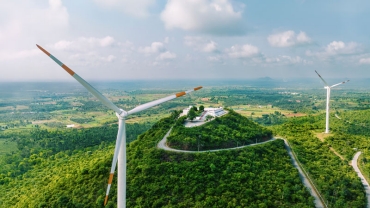
Getting H2 right: Producing at globally competitive prices
Australia must identify and capitalise on existing advantages
Australia’s low-cost renewable energy, with high-capacity factors and large-scale plants are key to producing at competitive hydrogen prices in the long term. Short-term challenges include high electrolyser costs, requiring greater utilisation of the electrolyser for repayment of capital for early adopters. For a renewable power plant plus electrolysis project, electrolyser utilisation can be increased by ‘over-sizing’ the power plant component; however this requires trade-offs with greater capital costs and potential redundancy.
PwC is observing this in our clients’ projects, where the inclusion of wind or grid-import power allows for a more cost-effective levelised cost of hydrogen (LCOH).
According to the Clean Energy Finance Corporation (CEFC), hydrogen produced by renewable energy is forecast to become cost-competitive with grey hydrogen between 2030 and 2040, leaving an economic gap to be bridged for projects over the next decade.
Developers of projects today need to think innovatively about project configuration, including electrolyser sizing, solar redundancy, grid import and hybrid systems such as wind or hydro. Australia can offer this multi-technology approach and provide developers with optionality over the optimal project configuration. The benefit of acting today is gaining a better understanding of how best to configure projects for cost optimisation.
Australia also has a wealth of existing industrial and export infrastructure that can be repurposed for a hydrogen industry if enabled to do so. A risk is that investment in any infrastructure upgrade could become a sunk cost if the shipping, storage, and port infrastructure aren’t able to cater for what proves to be the ‘winning’ hydrogen carrier (liquid hydrogen, ammonia, methylcyclohexane). Domestic developers are therefore partnering with international customers early in project development to ensure that the form of export meets the offtaker’s demands, whilst others are exploring multiple forms of export.
Selecting the right sites will be critical
Site optimisation and configuration for large-scale projects is paramount. Access to water is crucial for hydrogen projects, with nine kilograms of high-purity water required per kilogram of green hydrogen produced. Compared with Australia’s mining and agriculture sectors, water usage for hydrogen is expected to be minor, with the water required to meet Japan’s hydrogen demands by 2030 forecast at less than 1% of the Australian mining sector’s current water usage.
Freshwater, desalinated water and recycled water are all options that can be considered for hydrogen production projects, providing trade-offs between site selection, water availability and purity, and incremental cost. As the hydrogen industry matures, levels of economic, social, and cultural acceptance of water use for hydrogen production may shift.
Dedicated infrastructure will be needed if hydrogen is to be transported over vast distances domestically (such as from an inland location to the point of export), either by compressed trucking, rail or hydrogen-suitable pipelines. On the other hand, direct access to valuable portside land will attract significantly higher lease costs and be unlikely to provide sufficient space for co-located renewable generation. To achieve green accreditation, portside projects may need to enter into bundled power purchase agreements and accept the associated transmission and distribution costs. The New South Wales Hydrogen Strategy looks set to help with the latter by providing a 90% exemption to network charges for electrolysers in operation by 2030.
Australia needs to enable the hydrogen industry to drive down costs, fast
If enabled to do so, Australia’s cost of production of hydrogen will continue to decline rapidly to 2050, primarily driven by:
Reductions in the cost of large-scale electrolysers
Green hydrogen projects reaching scale will provide confidence to global equipment providers to finance improved electrolyser manufacturing facilities with increased automation. Similar to trends in the solar and wind industries, bringing down the cost of electrolysers will largely be driven by global developments, such as increased spending on research and development, availability of components, and manufacturing at Gigawatt scale.
The CEFC’s 2021 report forecasts that current capital costs of electrolysers of around A$1.1 million per megawatt will fall rapidly to around A$0.5 million per megawatt by 2050, fully installed. Several market commentators and manufacturers forecast an even more aggressive reduction in capital costs over a shorter timeframe.
- Increasing efficiency of electrolysers – requiring less energy for production of hydrogen
Innovation in electrocatalysts, fuel cells, conversion to hydrogen carriers and overall electrolyser efficiency is occurring rapidly. As these developments graduate from university research institutions, including many in Australia, and benefit from increasing availability of private funding, the industry will benefit from efficiency gains in the hydrogen production process. This will reduce energy requirements and increase the overall capacity factor of the system.
- Growing the domestic manufacturing capability – avoiding supply-chain bottlenecks in the move to GW scale
No major electrolyser manufacturing facilities are currently based in Australia. Australia faces the risk of having limited buying power globally, with key electrolyser manufacturers focusing on larger demand centres including Europe and the Middle East. Domestic manufacturing would provide security of supply to Australia’s large-scale projects and present an opportunity to revitalise our onshore manufacturing and export of intellectual property. For example, Fortescue Future Industries has announced a 2 GW electrolyser manufacturing facility in Queensland, which is set to capitalise on this opportunity for Fortescue’s own green hydrogen projects and to service a growing customer base for electrolysis projects.
- Sustained low-cost renewable electricity in Australia – available for the production of H2
Electricity supply represents 50% to 70% of the green hydrogen production cost, depending on system size and electrolyser technology. Fulfilling Australia’s promise as a green hydrogen export leader will depend on sustaining low-cost renewable electricity at scale, to provide a high-capacity factor and low operating cost base. The sustained roll-out of low-cost solar and wind generation is therefore key to cheaper hydrogen production, as is continued decarbonisation of the grid, including the roll-out of renewable energy zones (REZs).
Increased renewables in the electricity network can also be complemented by hydrogen production. Hydrogen can provide a storage mechanism for excess renewable capacity as well as another pathway for firming generation. These services are expected to be increasingly valuable as the grid increases its transition to variable renewable energy and may attract payments for capacity or system stability benefits. This effect may allow for further integration of renewables into the National Electricity Market with improved demand response from the grid.
Opportunity awaits
PwC’s Future of Energy Hub has released a global hydrogen analysis tool, forecasting hydrogen production costs internationally and demonstrating Australia’s opportunity to be a leader in production and export. The table below shows Australia’s forecast green hydrogen production costs over time, declining rapidly by 2040 to the joint-lowest cost globally, on par with that of its key export competitors.
| Australia’s forecast green hydrogen production cost | |
| AUD/kg | |
| 2025 | 5.70-6.10 |
| 2030 | 4.10-4.50 |
| 2040 | 2.00-2.45 |
| 2050 | 1.65-2.05 |
PwC Analysis of bottom-up cost estimates to produce green hydrogen
Over the longer term, there is great potential for Australia to play a leading role in a globally traded hydrogen market – but this is not a time to watch and wait. The success factors above will not occur by chance. Australia must put this opportunity at the forefront to demonstrate its intent and conviction in a green hydrogen future, or risk innovation and investment being deployed elsewhere.
Throughout our Getting H2 right series, we have looked at Australia’s path to building a competitive hydrogen industry, from establishing a hydrogen-ready supply chain and engaging partners and offtakers, through to navigating policy and regulation and getting the price right. These success factors will need to be considered by project developers and investors as projects progress towards construction and operation. The factors remain essential for both individual projects looking to secure financing, and for the development of the wider hydrogen economy.
Contact us
Contact us

Jon Chadwick
Partner, Advisory, Climate Lead & Global PwC Energy Transition Lead, PwC Australia











